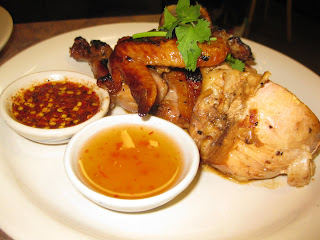
Pad thai has gotten a reputation as the thing that unadventurous Americans always order at Thai restaurants, but it's actually an excellent dish. Who could not love comforting rice noodles and shrimp stir-fried with sweet, salty and sour flavors, topped with ground peanuts and fresh green onions?
Well okay, actually I have had a number of bad restaurant versions, achingly sweet and/or suspended in thick, gooey sauce. Kasma Loha-Unchit, a Thai cooking instructor in San Francisco, explains that the gooey restaurant texture that many Americans have come to prefer is achieved through tomato ketchup.
Kasma's recipe, which inspired my version below, is drier than the typical restaurant pad thai, with a complex range of flavors and textures.
Pad thai is made with bean sprouts, which neither John nor I like. I am slightly allergic and he considers them "barely food," so I have omitted them here. If you like, add a handful to the wok in step 7.
1. Soak 1/2 pound of dried rice noodles in hot water for 30 minutes (while you do the prep in steps 2 and 3) until noodles are limp but still firm to the touch. Drain.
2. Mix 3 T. fish sauce, 3 T. tamarind juice, and 2 T. palm or white sugar. Taste and adjust seasonings to achieve a balance of salty, sweet and sour.
3. Peel and devein 1/3 pound of shrimp. Cut 3/4 cup of firm pressed tofu (found in any Asian grocery) into matchsticks. Mince 4-5 garlic cloves and thinly slice 3 shallots. Cut 5 scallions or garlic chives into 1 1/2-inch segments. Cut a lime into wedges. Crush 2/3 cup roasted peanuts. Measure out 1/4 cup dried shrimp and 2-3 T. ground chillis.
4. Heat a wok until it smokes, add a bit of peanut oil, and quickly stir-fry the shrimp just until they turn pink. Sprinkle them with fish sauce and remove from the wok.
5. Add the tofu to the wok, frying 1-2 minutes until golden. Add the garlic and shallots, then the dried shrimp and ground chillis.
6. Now add the drained noodles, tossing well with the other ingredients. Once the noodles have changed texture and softened, push the mass up along one side of the wok. Add a bit of oil to the cleared area, crack 3 eggs onto it, and scramble lightly. Once they have set, toss them in with the noodles.
7. Add the sweet and sour seasoning mixture, stirring well to coat the noodles evenly. Adjust the flavors. Add the scallions or chives, the shrimp and half the peanuts to the wok. When the greens are slightly wilted, transfer to a serving platter and garnish with the rest of the peanuts and the lime wedges.
 The essence of Thai food is a balance of sweet, salty, sour, spicy and, more occasionally, bitter. Unfortunately, what we get in restaurants is frequently one-dimensional — simply sweet, or "level 10 spicy." Thankfully, John and I found S&I Thai, a takeout dive in Allston that cooks just like the best of what we had in Bangkok. They don't wimp on the chilli fire — or any of the other taste elements that make Thai cuisine so wonderful
The essence of Thai food is a balance of sweet, salty, sour, spicy and, more occasionally, bitter. Unfortunately, what we get in restaurants is frequently one-dimensional — simply sweet, or "level 10 spicy." Thankfully, John and I found S&I Thai, a takeout dive in Allston that cooks just like the best of what we had in Bangkok. They don't wimp on the chilli fire — or any of the other taste elements that make Thai cuisine so wonderful .
. of pork, leaving it crispy and savory, then stud it with chillis and basil. The Thai barbecued chicken with sticky rice is also to die for. Order it with a side of som tam (papaya salad).
of pork, leaving it crispy and savory, then stud it with chillis and basil. The Thai barbecued chicken with sticky rice is also to die for. Order it with a side of som tam (papaya salad). of pork, leaving it crispy and savory, then stud it with chillis and basil. The Thai barbecued chicken with sticky rice is also to die for. Order it with a side of som tam (papaya salad).
of pork, leaving it crispy and savory, then stud it with chillis and basil. The Thai barbecued chicken with sticky rice is also to die for. Order it with a side of som tam (papaya salad).


















